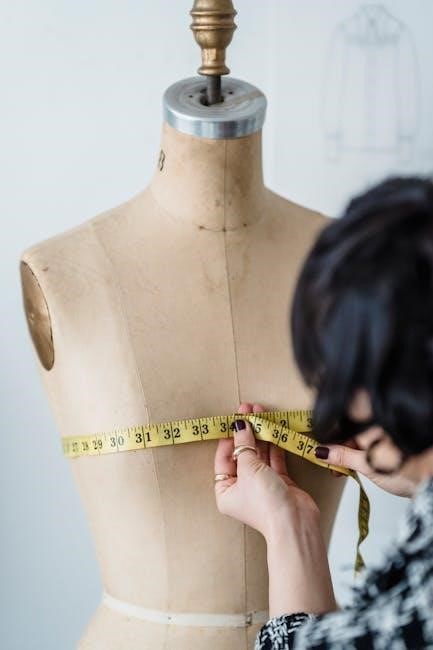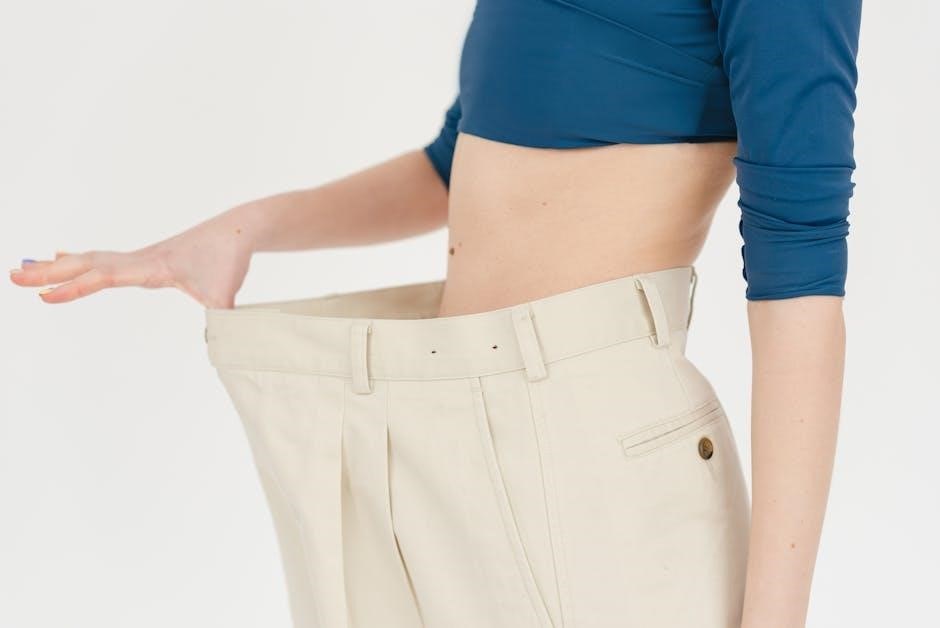The Kay Unger Size Guide offers a detailed chart to ensure optimal fit, featuring precise measurements for bust, waist, and hips. It helps determine the perfect size, considering fabric stretch and body type for a flattering silhouette. This tool is essential for selecting garments that align with your proportions, ensuring comfort and style.
Overview of the Kay Unger Brand
Kay Unger is a renowned American fashion brand celebrated for its understated elegance and timeless designs. With over 50 years in the industry, the brand has established itself as a leader in women’s apparel, offering sophisticated and versatile pieces; Kay Unger’s collections blend classic styles with modern touches, catering to a wide range of body types and preferences. The brand is particularly noted for its attention to detail and commitment to quality, ensuring garments that flatter and empower. Kay Unger’s sizing system is designed to provide a seamless fit, reflecting the brand’s dedication to inclusivity and comfort. By combining exquisite craftsmanship with a deep understanding of women’s needs, Kay Unger continues to be a trusted name in fashion.
Importance of Using a Size Guide
Using the Kay Unger Size Guide is essential for ensuring a perfect fit and a flattering silhouette. It provides precise measurements for bust, waist, and hips, helping you select the ideal size for your body type. Accurate sizing reduces the need for returns and exchanges, saving time and effort. The guide also accounts for fabric stretch and proportions, ensuring comfort and style. By referencing the size chart, you can confidently choose garments that align with your measurements and preferences. This tool is particularly helpful for online shoppers who cannot try items before purchase. Ultimately, the Kay Unger Size Guide enhances your shopping experience by delivering a tailored fit that boosts confidence and satisfaction.

Understanding the Kay Unger Size Chart
The Kay Unger Size Chart provides a structured guide to help determine accurate measurements for bust, waist, and hips, correlating body measurements to garment sizes effectively.
How to Read the Size Chart
Reading the Kay Unger Size Chart involves aligning your body measurements with the corresponding garment sizes. The chart typically features columns for measurements (bust, waist, hips) and rows for sizes (e.g., 2-4, 6-8). Start by identifying your measurements, then match them to the nearest size range. Pay attention to the numerical ranges, as they indicate the fit for each size. For example, a bust measurement of 34-36 inches might correspond to size 6-8. Use the chart to determine the best fit based on your body type and the specific garment’s design. Always double-check the measurements to ensure accuracy and consider whether you prefer a relaxed or fitted silhouette. Proper alignment ensures a flattering and comfortable fit.
Key Measurements: Bust, Waist, and Hips
The bust, waist, and hips are the three fundamental measurements used in the Kay Unger Size Guide to determine your size accurately. The bust measurement is crucial for ensuring a proper fit in tops and dresses, while the waist measurement helps define your silhouette and is essential for tailored garments. Hip measurements are vital for determining the fit of pants, skirts, and dresses, especially those that are fitted through the hips. By focusing on these key areas, you can align your body proportions with the size chart to find the most flattering and comfortable fit. Accurate measurements in these areas ensure the best fit and style, allowing your garments to drape well and provide the desired comfort and style.

How to Properly Measure Your Body
Using a flexible tape measure, stand straight with feet together and muscles relaxed. Ensure the tape isn’t too tight or loose. Record measurements accurately for the best fit.
Measuring Your Bust Accurately
To measure your bust accurately for the Kay Unger size guide, start by standing straight with your feet together and muscles relaxed. Use a flexible tape measure and ensure it is not too tight or loose. Place the tape measure around the fullest part of your bust, typically across the nipple line, keeping it parallel to the floor. Make sure the tape lies flat against your skin without twisting or bunching. Take the measurement while wearing no clothing or a non-padded bra for accuracy. Record the measurement by looking straight ahead and noting where the tape aligns on the size chart. For the best fit, take multiple measurements to ensure consistency. If your size falls between two numbers, consider rounding up for comfort, and refer to Kay Unger’s specific guidelines for in-between sizes.
Measuring Your Waist and Hips Correctly
To measure your waist accurately, locate your natural waistline, which is the narrowest point above your belly button and below your ribcage. Stand straight and wrap a flexible tape measure around this area, ensuring it is parallel to the floor and not too tight or loose. For your hips, measure around the widest part, typically 7-9 inches below your waistline. Keep the tape measure level and parallel to the floor. Avoid pulling the tape too tight, as this can lead to inaccurate sizing. For the most precise results, wear a lightweight garment or no clothing, and take multiple measurements to ensure consistency. Record the largest measurement for your hips and use it to match Kay Unger’s size chart for the best fit. Accuracy in these measurements ensures a flattering and comfortable fit in your chosen garment.

Factors Affecting Fit and Size
Body type, proportions, and fabric type significantly impact fit. Different body shapes require tailored cuts, while fabric stretch and drape influence comfort and sizing accuracy.
Body Type and Proportions
Your body type and proportions play a crucial role in determining the best fit. Kay Unger’s size guide caters to various body shapes, including pear-shaped, hourglass, and rectangular frames. Understanding your body type helps identify areas where garments may need adjustment. For example, individuals with longer torsos may require slightly longer styles, while those with curvier figures may benefit from designs with more room in the hips and bust.
Proportions, such as the ratio of your bust to waist to hips, also influence how garments fit. Accurate measurements ensure that the size chosen aligns with your natural shape, providing comfort and a flattering silhouette. Considering these factors helps you make informed choices when selecting sizes from the Kay Unger collection.
Fabric Type and Stretch
Fabric type and stretch significantly impact how garments fit. Kay Unger designs often use fabrics with varying levels of stretch, from form-fitting knits to structured wovens. Understanding the fabric’s elasticity is crucial for choosing the right size. Stretchy fabrics, like jersey or spandex blends, provide flexibility and mold to your body, while non-stretch fabrics, such as cotton or silk, offer a more rigid fit. The natural give of the fabric can affect how measurements align with the size chart. For instance, stretchy fabrics may allow for a snugger fit, while non-stretch fabrics require precise measurements to ensure comfort. Always consider the fabric’s properties when selecting your size to achieve the best fit and comfort.

Choosing the Right Size for Your Body
Accurately measure your body to align with the size chart. Choose a size that ensures comfort and a flattering fit, confirming the best possible match.
How to Determine Your Size Using the Chart
To determine your size using the Kay Unger size chart, start by accurately measuring your bust, waist, and hips. Locate these measurements on the chart and identify the corresponding size. Each size corresponds to specific measurements, so align yours carefully. Consider your body type and how fabrics may affect fit. If your measurements fall between sizes, choose the larger size for non-stretch fabrics or the smaller size for stretchy materials. Double-check your measurements to ensure accuracy and avoid common sizing mistakes. By following these steps, you can select a size that provides a comfortable and flattering fit, enhancing both the appearance and comfort of your garment.
When to Consider Sizing Up or Down
When using the Kay Unger size chart, consider sizing up if your measurements fall between sizes or if you prefer a looser fit. This is especially true for non-stretch fabrics, as they offer less flexibility. Conversely, size down if you prefer a snug fit or if the garment is designed to be form-fitting. Body proportions, such as a longer torso or broader shoulders, may also influence your decision. If you’re unsure, compare your measurements to the chart and consider the fabric type. For stretchy fabrics, sizing down may be appropriate, while for structured garments, sizing up ensures comfort. Always double-check your measurements and personal fit preferences to make the best choice.

Tips for Taking Care of Your Garment
Properly care for your Kay Unger garment by washing in cold water, avoiding machine drying, and using a fabric steamer for wrinkles. Store in a cool, dry place, away from direct sunlight to preserve color and fabric integrity. Avoid plastic bags, as they can trap moisture and cause mildew. Follow these tips to maintain the quality and longevity of your garment.
Washing Instructions to Maintain Fit
To maintain the fit and quality of your Kay Unger garment, wash it inside out in cold water using a mild detergent. Avoid using bleach or harsh chemicals, as they can damage fabrics. For delicate or embroidered pieces, consider hand washing to prevent damage. Gently swish the garment in the water, then rinse thoroughly. Do not wring or twist, as this can stretch or distort the fabric. Lay the garment flat to air dry, reshaping it to its original dimensions while damp. Avoid machine drying, as heat can shrink or misshape the fabric. For wrinkles, use a fabric steamer or iron on a low setting. Proper washing and drying techniques will help preserve the fit and extend the life of your garment.
Storage Tips to Preserve Your Garment
To preserve your Kay Unger garment, store it in a cool, dry place away from direct sunlight. Use a breathable fabric bag or acid-free tissue paper to maintain airflow and prevent moisture buildup. Avoid storing in plastic bags, as they can trap humidity and cause damage. For hanging items, use padded hangers to maintain the garment’s shape and avoid stretching. Folded items should be placed in a drawer, separated by tissue paper to prevent creasing. Avoid overcrowding storage spaces, as this can cause wrinkles or distortion. Clean the garment before storing to prevent stains from setting in. For long-term storage, consider refolding or rehanging the garment every few months to maintain its shape and prevent fabric fatigue.

Brand-Specific Information
Kay Unger offers tailored fits, premium fabrics, and timeless designs, ensuring a sophisticated look for every body type. Their sizing is crafted for comfort and elegance.

Kay Unger’s Approach to Sizing
Kay Unger’s sizing approach emphasizes precision and consistency, ensuring garments fit flawlessly across diverse body types. The brand meticulously crafts size charts based on standard measurements, reflecting real-world proportions. By focusing on tailored cuts and balanced proportions, Kay Unger delivers a fit that combines comfort and style. Their sizing system is designed to accommodate various figures, from petite to curvier frames, without compromising on elegance. Each garment is carefully measured and tested to ensure accuracy, making the size guide a reliable tool for customers. Kay Unger’s commitment to quality and attention to detail ensures that every piece flatters the wearer, providing confidence and sophistication. This approach helps customers find their perfect fit effortlessly, aligning with the brand’s mission to empower women through fashion.
Unique Features of Kay Unger Designs
Kay Unger designs are renowned for their timeless elegance and sophisticated appeal. The brand incorporates premium fabrics, such as luxurious silks and fine wools, ensuring exceptional quality and comfort. Designs often feature intricate details like embroidery, beading, or subtle patterns, adding a touch of refinement. Kay Unger’s collections emphasize classic silhouettes with modern twists, catering to women who value both style and versatility. The garments are crafted to flatter diverse body types, with tailored cuts and balanced proportions. Additionally, many designs offer stretch or adjustable elements for a customizable fit. This blend of craftsmanship, attention to detail, and wearable artistry makes Kay Unger’s creations stand out in the world of fashion, offering pieces that are both enduring and chic.

How to Use the Size Guide Effectively
Align your measurements with the Kay Unger size chart to find your perfect fit. Consider fabric stretch and personal comfort preferences for optimal sizing decisions.
Matching Your Measurements to the Chart

To accurately match your measurements to the Kay Unger size chart, start by identifying your bust, waist, and hip measurements. Locate these numbers in the chart and find the corresponding size. Ensure your tape measure is level and snug but not too tight. If your measurements fall between two sizes, consider your personal fit preference—opt for the smaller size for a tighter fit or the larger size for comfort. Double-check that your measurements align with the chart’s columns to avoid mismatches. Pay attention to whether the chart uses inches or centimeters, and verify the measurements correspond to your body type. This method ensures a precise fit, allowing you to select the most flattering size from Kay Unger’s collection with confidence.
Common Mistakes to Avoid When Sizing
When using the Kay Unger size guide, avoid common pitfalls to ensure the best fit. One mistake is not taking accurate body measurements, as loose or tight tape measures can lead to size misjudgment. Another error is ignoring body type and proportions, which can affect how garments fit. Some individuals overlook fabric stretch or assume all designs have the same sizing, which isn’t always true. Additionally, failing to check the size chart for specific styles can result in poor fit, as some designs may vary slightly. To avoid these errors, measure carefully, consider your body type, and review the chart for each item. This attention to detail ensures a flattering and comfortable fit from Kay Unger’s collection.
The Kay Unger size guide is an essential tool for achieving the best fit in their elegant designs. Accurate body measurements are crucial, focusing on bust, waist, and hips. Understanding your body type and fabric stretch helps in selecting the right size. Always refer to the size chart and avoid common sizing mistakes. Proper garment care, like washing in cold water and storing items neatly, ensures longevity. Kay Unger’s sizing approach emphasizes comfort and flattering silhouettes, making their designs versatile for various occasions. By matching your measurements to the chart and considering fit nuances, you can confidently choose garments that enhance your style and comfort. Remember, proper fit is key to enjoying your Kay Unger pieces for years to come.
Final Tips for the Best Fit
For the ultimate fit in Kay Unger designs, always double-check your measurements and compare them to the size chart. Consider the fabric’s stretch and how it drapes on your body. If unsure, size up for comfort or down for a snug fit. Don’t hesitate to seek professional alterations for a tailored look. Proper care, like avoiding over-drying and storing garments flat, preserves the shape. Remember, fit is personal, so trust your comfort level. By combining accurate measurements, understanding fabric, and following care tips, you’ll enjoy a flawless fit that enhances your confidence and style. Make these practices a habit for long-lasting, impeccable results with Kay Unger pieces.
